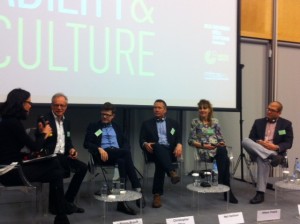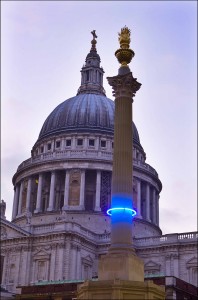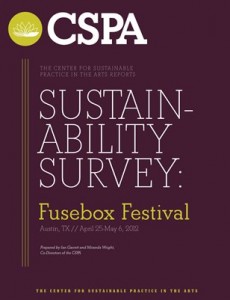 I've recently returned from the MITOS21 Conference in Thessaloniki (http://sustainability-culture.thessalonikiconference.org/), Greece where I was invited to represent the US approach to issues of sustainability in arts presentation in terms of policy and programming with our European colleagues.
I've recently returned from the MITOS21 Conference in Thessaloniki (http://sustainability-culture.thessalonikiconference.org/), Greece where I was invited to represent the US approach to issues of sustainability in arts presentation in terms of policy and programming with our European colleagues.
My presentation was on the impact of sustainability and climate policy in the US (or lack there of) on the Arts. Following my presentation I shared the stage with Moderator Iphigenia Taxopoulou (General Secretary, Mitos21), Simon Brault (Vice-Chair, Canada Council for the Arts & CEO, National Theatre School of Canada), Christopher Miles (Deputy Cabinet Director, of the Minister of Culture, France), Neil Darlison (London Director, Theatre, Arts Council of England) and Alison Tickell (CEO, Julie’s Bicycle, London), Ian
 Representatives of political authorities from Greece and abroad, cultural policy-makers and experts from various fields were gathered to map out and shed light from different perspectives on this emerging international regulatory framework, i.e. how the principle of sustainability is endorsed in national and supranational cultural policies and how it is reflected in instruments that are directly or indirectly linked with the field of culture, such as the relevant European policies, EU directives, legislation, economy, development.
Representatives of political authorities from Greece and abroad, cultural policy-makers and experts from various fields were gathered to map out and shed light from different perspectives on this emerging international regulatory framework, i.e. how the principle of sustainability is endorsed in national and supranational cultural policies and how it is reflected in instruments that are directly or indirectly linked with the field of culture, such as the relevant European policies, EU directives, legislation, economy, development.
Below is the text of my talk on the impact of US climate policy on the Arts sector:
The Unites States is the largest per capita contributor to greenhouse gases in the world. Yet climate change remains a political minefield, deeply tied to strong and varied political and commercial interests. More and more, building regulation is integrating requirements for sustainable design into new construction, resulting in a rising number of LEED (leadership in energy and environmental design) certified cultural facilities. While facilities are trending toward "going green," operations, as well as creative practices in museums, theatres and music halls often do not correlate to the building's environmental standards. US policy and public discourse around sustainability is a complex, problematic and varied topic.
In the International Federation of Arts Councils and Culture Agencies' (IFACCA) report on Arts and Ecological Sustainability from January 2009, it's stated that: "the arts sector is uniquely positioned to inform public debate on climate change and to explore solutions. Examining worldviews, social realities and physical circumstances has been a concern of the arts since prehistory. As public concern about climate change and other ecological issues grows, so does the engagement of arts practitioners with these issues"
This view has found it's way into many policies governing the dispersal of public money to arts organizations. Some of this manifests in operational consideration, some of it in the management of facilities. However, in the United States, neither approach has been consider outside of isolated examples in terms of arts funding.
Theatrical Outfit in Atlanta Georgia was the first LEED certified theatre in the US, but barely make note of it, aside from a subpage on their website. More widely known, Portland Center Stage in Portland, Oregon became LEED Platinum when opening the Gerding Theatre at the Armoury in 2006. A number of building projects began to develop soon after. New York Theatre Workshop began work on what would be a LEED Gold workshop across the street from their performance facilities on 4th street on New York's Lower East Side. Brooklyn based Theatre for a New Audience began a capital campaign for a new space, intended to seek LEED certification (and currently nearing completion) (jean guy lecat). In Los Angeles, the grant that essential started the CSPA came from the Centre Theatre Group and was tied to the renovation of the Mark Taper Forum and building the brief for an Arts Leadership building to replace all of the offices for organizations resident to the Music Center in downtown LA. As these LEED certified arts projects grew in number, a common theme emerged as well: The buildings might have been "green", but no specific efforts had been made to consider what was on stage. This fact, stated plainly in a 2007 site visit to Portland, led to a number of the research efforts of the CSPA looking at production.
Many of these projects were either halted or stopped as a result of the 2008 economic downturn. Those which have completed have been able to integrate their LEED aspirations in their buildings, but often times this can come out of the codification of LEED standards into building codes. For instance, it's not possible to complete a building using any public funding on Manhattan without essentially meeting LEED Gold standards. Since it's nearly impossible to build at all in that area without public funds, this had resulted in a growth of green building, certified or not.
In fact, in recent conversations with architectural consultants and members of the USGBC, a rising area of concern is the possibility of a future where LEED certification is no longer an aspiration. All of that standard's marks for certification are slowly being incorporated into building code.
In this way, policy in the US has had a direct impact on development, capitalization and management of arts facilities. These buildings are rarely made without some public funding component. As a result, more and more are being built green out of requirement. This does vary widely across the nation though, as these policies are typically established at the municipal or state level. There is yet no federal policy that factors into this equation. Until President Obama's second inaugural address this past January, there really hasn't been a clear federal sustainability or climate agenda to speak of, and that intention has yet to be acted upon. Only 38 of the 50 states in the United States have established policy on sustainability. 4 of those have yet to complete their sustainable action plans. That leaves 12 states without any clear policy on sustainable or climate issues.
Though there may be little policy that impacts the arts and culture sector with regards to issues of sustainability, this hasn't prevented action from being taken. Though there is yet to be any larger funders, such as the Doris Duke or Andrew Mellon Foundations, who have taken up the cause of sustainability in arts and culture (despite having separate funding priorities in both arts and environmental issues which do not overlap), there have been ambitious initiatives which have been funded. The Mo'olelo Performing Arts Company in San Diego developed their Green Theatre Choices Toolikit in partnership with Brown & Wilmanns Environmental, LLC with funding from the MetLife Foundation. Childsplay in Phoenix, Arizona has been doing important research around lumber issues in scenic construction. In New York, Los Angeles, and Phillapelphia new infrastructural projects dealing with sharing of resources across theatrical communities have started independently of one another with support from their municipal arts agencies and primary funding coming directly from the potential user base.
A recent change of interest though has been coming from our work in our idea of Cultural Offsetting. An idea, which has in part been inspired by a conversation I had with Alison Tickell, also on this panel, in 2009, which relates to the potential for positive environmental outcomes based on gathering people in one place. We've seen promising data that potential energy consumption is less in theatres and at concerts than would be estimated to be consumed by audience if they were at home. Our initial data 15% less and emerging data 15-40% of that. With the development of methodologies for estimating the carbon footprint of audience and artist travel, expected economic impact based on cultural participation, better metrics for energy and resource consumption compared against typical audience behaviours, we feel that it is likely that cultural participation is better for the planet than people sitting at home. This has led to two thoughts:
One, that by measuring the environmental impacts of cultural activities we can show that without any change, these events are already more eco-positive than no activity. And, that this has led to more interest in sustainable change; the conversation about changes is now generally positive and meets with less resistance as a result of starting from a place of immediate benefit, diffusing resistance that originates from an expectation of future restrictions.
And, Two, that changes, even small changes, which--with regards to the actual footprint of an event--may lead to nearly negligible reductions in that isolated footprint, are magnified in direct proportion to audience participation in such events. Further combined with the public awareness that is possible by tying sustainable themes to content or around content, the potential impact of arts and cultural activity may have greater return than that invested in building projects.
This all really just restates, in a way which is connected to tangible administrative outcomes, the IFACCA summary from 2009. And, as a result we've been able to peak the interest from funders, including those tied to public investment in culture as a clear way to connect these priorities. So while there may not be clear policy affecting arts and culture in the United States in terms of sustainability, there may finally be a way of understanding the connection in our philanthropic system of support which often relies on a pure capitalist approach tied to returns as dollars, visibility or social impact, to really take hold.




